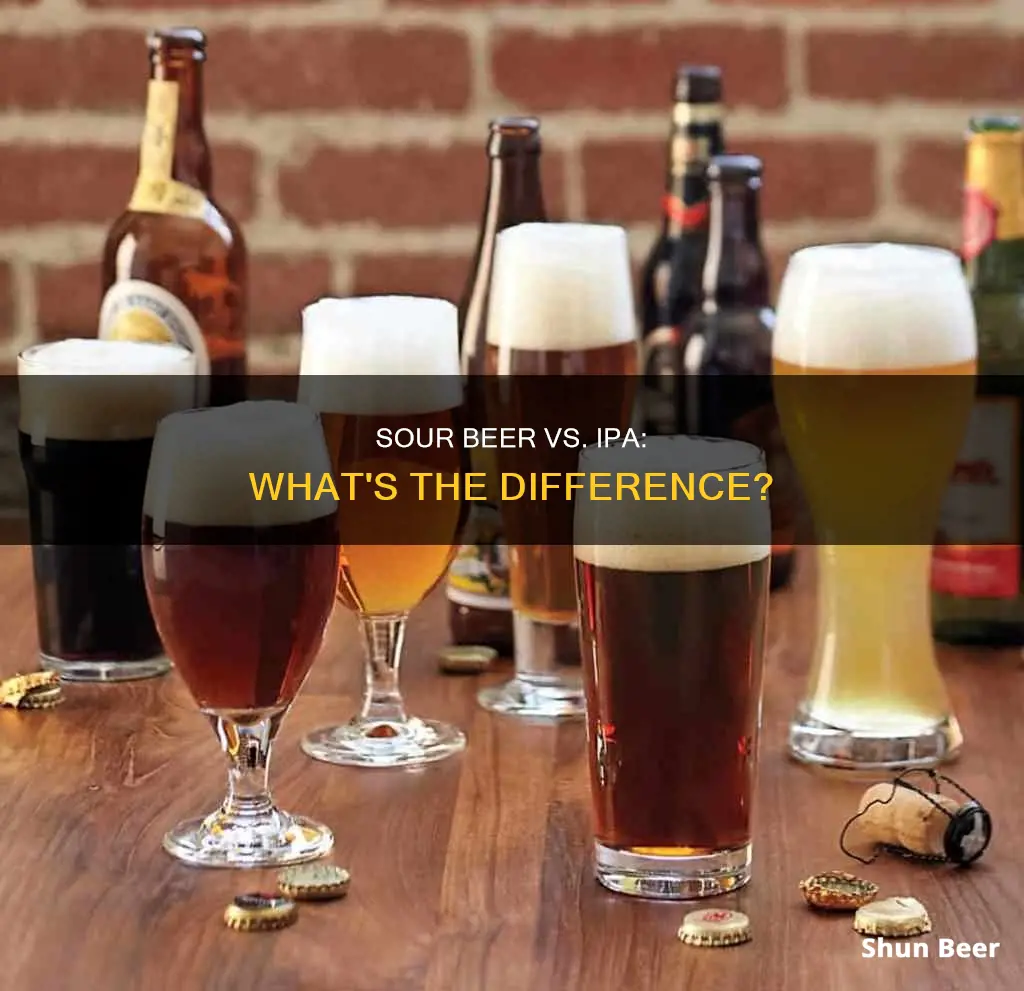
Sour beer is a broad category of beer with various substyles, all characterised by intentionally acidic, tart, or sour flavours. One such substyle is the Sour IPA, which is a relatively new hybrid style that combines the tartness of a sour beer with the hoppiness of an IPA. The result is a beer with low bitterness, maximum fruity hops, a soft mouthfeel, and sourness.
| Characteristics | Values |
|---|---|
| Flavour | Sour, tart, hoppy, fruity |
| Ingredients | Lactobacillus, hops, fruit purée, vanilla, lactose |
| Taste | Intense, refreshing, bitter, sweet |
| Brewing technique | Kettle souring, spontaneous fermentation |
| Alcohol content | 5.5% to 6.5% ABV |
What You'll Learn

Sour IPAs are made with soft malts, trendy hops, and fruit purées
Sour IPAs are a unique style of beer that combines the tartness of a sour beer with the hoppy, fruity character of an IPA. While sour beers are typically made with wild yeasts and bacteria, sour IPAs incorporate specific ingredients and techniques to create a complex and intriguing flavour profile.
At their base, sour IPAs are made with soft malts, such as wheat or oats, which contribute to a soft, lazy mouthfeel that is distinct from the crisp, clean sharpness of traditional IPAs. These soft malts are often complemented by milk sugar, also known as lactose, which adds a supple, lush mouthfeel and a touch of sweetness that balances out the acidity in the beer.
The hops used in sour IPAs are carefully selected to enhance the fruity and tropical flavours that are desired in this style. Lower temperatures are used during the brewing process to highlight the botanical character of the hops without adding bitterness. Dry-hopping, a process where hops are steeped in fermenting beer instead of being added during boiling, is also commonly employed to amplify the fruity, piney, and candy-sweet notes of the hops while avoiding any additional bitterness.
Fruit purées are also a key component of sour IPAs. The addition of fruit contributes to the overall tartness of the beer while also injecting tropical flavours, candied sweetness, or a touch of acidity. Fruits such as peaches, blueberries, lemons, and strawberries are commonly used, adding a layer of complexity and a playful twist to the beer.
The combination of soft malts, carefully selected hops, and fruit purées results in a sour IPA that is both intriguing and approachable. The balance of precision and joy in these beers creates a style that appeals to both beer enthusiasts and those new to the world of craft beer.
German IPAs: A Unique Take on a Classic Style
You may want to see also

Sour IPAs are a hybrid of New England IPAs and sour beer
Sour IPAs are a unique hybrid of New England IPAs and sour beer. They combine the tartness of a sour beer with the hoppiness of a New England IPA, creating a complex and intriguing flavour profile. While the idea of combining these two styles may seem unusual, the result is a well-balanced and refreshing beer that has gained a dedicated following.
The key to a Sour IPA is the addition of acid, which is typically achieved through a process called kettle souring. This technique involves souring the unfermented wort over a short period, usually between 24 hours and several days. Lactobacillus, a type of microorganism, is commonly used in this process, adding a distinctive tart characteristic to the beer. Lactobacillus plantarum is particularly well-suited for brewing Sour IPAs due to its ability to rapidly create acidity.
The creation of Sour IPAs can be attributed to innovative brewers who wanted to experiment with new flavours. One notable example is Hudson Valley Brewery, which began innovating with Sour IPAs in the late 2010s. Their beers, such as "Bloom", combine unique ingredients like raw wheat, malted oat, milk sugar, cherries, dark chocolate, and chamomile, resulting in a complex and surprising flavour profile.
While Sour IPAs may not have reached the same level of popularity as hazy IPAs, they represent a fascinating exploration of flavour possibilities. The challenge of balancing bitter and sour flavours makes Sour IPAs a niche style that appeals to those seeking something unique and experimental in the craft beer world. However, the demand for Sour IPAs is growing, and they are gaining recognition as a cult favourite among beer enthusiasts.
The creation of Sour IPAs showcases the creativity and innovation within the brewing industry. By combining elements of New England IPAs and sour beer, brewers have crafted a style that offers a unique sensory experience, showcasing the endless possibilities of flavour combinations in the world of beer.
Guinness Beer: Hoppy or Not?
You may want to see also

Sour IPAs are made through the kettle souring process
Sour IPAs are a unique style of beer that combines the hoppiness of an IPA with the tartness of a sour beer. While the combination of bitter and sour flavours is challenging to achieve, brewers have been able to create this alternative sensory experience through the kettle souring process.
Kettle souring is a technique that allows brewers to rapidly sour unfermented wort in a matter of days, often within 24 to 48 hours. This process is done in a stainless-steel mash tun, where the wort is cooled to a temperature between 75 and 115 degrees Fahrenheit (24 to 46 degrees Celsius) before a cultured strain of pure lactobacillus is introduced. Lactobacillus is a key additive in sour beers, as it consumes sugars in the wort and produces lactic acid, giving the beer its distinct sour flavour.
The kettle souring process is advantageous for several reasons. Firstly, it significantly reduces the time required to produce a sour beer, making it more accessible for brewers who do not want to wait months or years for traditional souring methods. Secondly, since the wort is soured and then boiled to kill the lactobacillus, there is no risk of infecting equipment or contaminating other batches. Finally, lactobacillus is highly sensitive to isomerized alpha-acids, so this method allows for a hoppier sour beer than traditional souring techniques.
To create a sour IPA, brewers often focus on hop varieties known for their super fruity qualities, as these complement the sour flavours better than bitter notes. Dry-hopping is a key technique, as it enhances the hop aroma and flavour without adding bitterness. Additionally, hop extracts can be used to soften the bitterness so that it harmonizes with the tart element instead of clashing with it.
Overall, the kettle souring process enables brewers to create sour IPAs with a unique flavour profile that blends the characteristics of a sour beer with the hoppiness of an IPA. This innovative style offers beer enthusiasts an alternative sensory experience that challenges the traditional boundaries of beer flavours.
Does IPA Beer Contain Fat?
You may want to see also

Sour IPAs are not bitter, but have low bitterness
Sour IPAs are a relatively new hybrid style of beer that has become popular in the craft beer world. They are created by combining the characteristics of an India Pale Ale (IPA) with those of a sour beer. While IPAs are known for their bitterness, the addition of sour flavours creates a unique and complex taste profile that sets Sour IPAs apart.
The key to a successful Sour IPA lies in balancing the bitter and sour flavours. Bitter and sour flavours can clash in beer, resulting in an unpleasant taste experience. Therefore, Sour IPAs are crafted to have low bitterness and maximum fruity hops. This combination enhances the tropical and citrus notes commonly found in IPAs, resulting in a refreshing and vibrant beverage.
The sourness in Sour IPAs is typically achieved through the use of lactobacillus, a microorganism employed in the kettle souring process. This process involves souring the unfermented wort in a short period, usually between 24 hours and several days. Lactobacillus plantarum, a specific strain of lactobacillus, is particularly effective for brewing Sour IPAs due to its ability to rapidly create acidity.
In addition to the kettle souring process, brewers may also incorporate adjuncts such as fruit, vanilla, and lactose to enhance the flavour of their Sour IPAs. These ingredients add complexity and depth to the beer, creating a unique sensory experience.
While Sour IPAs offer a fascinating twist on traditional IPAs, they have not achieved the same level of popularity. The challenge of balancing bitter and sour flavours may be a contributing factor, as it requires a delicate approach to create a harmonious blend. However, for those who enjoy exploring new taste sensations, Sour IPAs present an intriguing option that combines the best of both worlds.
Guinness Beer: Extra Stout or Draught, What's Original?
You may want to see also

Sour IPAs are an advanced style to homebrew
Sour IPAs are a unique style of beer that combines the tartness of a sour beer with the hoppy, fruity character of an IPA. This style of beer is created through a process called kettle souring, where a microorganism called lactobacillus is used to sour the wort before fermentation. This process can take as little as 24 hours, but typically takes several days.
To create a sour IPA, brewers must also pay close attention to the ingredients they use. Sour IPAs are typically made with soft grains like wheat or oats, as well as milk sugar (lactose) to create a smooth and lush mouthfeel. The hops used in sour IPAs are typically added at lower temperatures to provide a botanical character that complements the other flavours in the beer.
Additionally, brewers may add adjuncts such as fruit, vanilla, or lactose to enhance the flavour of their sour IPAs. These adjuncts can be used to elevate the base beer and create a more complex and nuanced flavour profile.
Brewing a sour IPA also requires careful control of the fermentation process. The brewer must ensure that the lactobacillus has soured the wort to the desired level before moving on to the next steps. This can be challenging as the lower the pH, the higher the antimicrobial potency of hop compounds, which can inhibit the lactobacillus.
Furthermore, the timing of hop additions is crucial in a sour IPA. Hops are added at specific points in the brewing process to contribute different flavour and aroma characteristics. Brewers may also choose to dry-hop their sour IPAs to enhance the hop aroma and flavour without increasing bitterness.
Overall, brewing a sour IPA requires a deep understanding of the brewing process and the interactions between different ingredients. It is an advanced style that requires careful planning and execution to create a well-balanced and delicious beer.
Guinness Beer's Ball: A Unique Brewing Mystery
You may want to see also
Frequently asked questions
Sour beer is a beer with an intentionally acidic, tart, or sour taste. It is made by allowing wild yeast strains or bacteria into the brew.
IPA stands for India Pale Ale. It is a style of beer with many variations.
A sour beer is not an IPA. However, there is a style of beer called a Sour IPA, which is a hybrid between an IPA and a sour beer. Sour IPAs are made by adding sourness to the tropical flavors of an IPA, creating a lip-smacking acidity.







